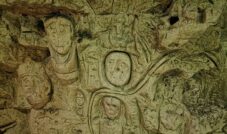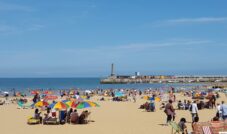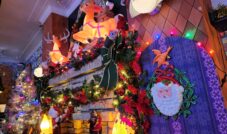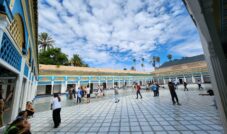My photos of Bateman’s House and Garden
Not to be confused with the guy who makes exceedingly good cakes… Rudyard Kipling is the author of the Jungle Books.
While his home was interesting to potter around, it’s the garden I loved the most.
Just look at these colours. It’s one of my most favourite gardens I’ve visited in the south east of England.


>
















30 interesting facts about Bateman’s
House & History
- Rudyard Kipling’s Sanctuary: Bateman’s was the beloved home of The Jungle Book author Rudyard Kipling from 1902 until his death in 1936. He described it as a house that “begged to be lived in.”
- Jacobean Architecture: Built in 1634, the house showcases classic Jacobean features, including mullioned windows, oak beams, and a central chimney stack.
- Preserved Interiors: Many rooms remain as Kipling left them, including his study, which still holds his writing desk and personal library.
- National Trust Stewardship: Kipling’s daughter donated Bateman’s to the National Trust in 1939, ensuring its preservation for future generations.
Gardens & Grounds
- 12 Acres of Tranquility: The gardens include a wildflower meadow, orchard, lily pond, rose garden, and even a working watermill known as Park Mill.
- The Mulberry Garden: Once a farmyard, Kipling transformed it into a formal garden with box-bordered beds. Today, it features seasonal displays of tulips, wallflowers, and vegetables.
- Productive Orchard: The orchard boasts apples, pears, plums, damsons, medlars, crab apples, and a black mulberry tree — with produce used in the on-site tea-room.
- Wild Garden Wonders: In spring, the wild garden bursts with flowering bulbs beneath ornamental trees, offering a sensory feast of colour and scent.
- Park Mill Legacy: Kipling used the watermill to generate electricity for the house — a rare example of early domestic hydroelectric power.
- RK Gate Design: The metal gate in the Mulberry Garden features stylised ‘RK’ initials, a subtle nod to Kipling’s personal imprint on the estate.
Historical & Literary Connections
- Kipling’s Nobel Prize: Rudyard Kipling won the Nobel Prize for Literature in 1907 — the first English-language writer to do so — while living at Bateman’s.
- Grade I Listed Status: The house was designated a Grade I listed building in 1961, recognising its architectural and historical significance.
- Kipling’s Writing Retreat: Kipling wrote many of his later works here, including Puck of Pook’s Hill and Rewards and Fairies, both inspired by the Sussex landscape.
- Family Atmosphere: The house retains a lived-in feel, as if the Kiplings have just stepped out — a deliberate curatorial choice to preserve its warmth.
- Second-Hand Bookshop: There’s a charming bookshop on-site, located on the ground floor of the house, offering Kipling titles and literary finds.
- Kipling’s Car: His 1928 Rolls-Royce Phantom I is displayed in the garage, reflecting his love of motoring and modern technology.
- Burwash Village Connection: Bateman’s is just a mile from Burwash, where Kipling was a familiar figure — often seen walking or driving through the village.
- Kipling’s Estate Expansion: Originally 33 acres, Kipling expanded the estate to over 300 acres, acquiring surrounding farmland to preserve the rural setting.
- Kipling’s Political Views: His study contains letters and memorabilia reflecting his imperialist views and involvement in public affairs — a window into his complex legacy.
- The Kipling Gardens: Though separate, Kipling also influenced gardens in Rottingdean, where he lived before Bateman’s — now open to the public.
Garden & Estate Highlights
- Quarterdeck Garden: A raised terrace offering views over the estate, named after Kipling’s nautical interests and love of ships.
- Seasonal Displays: The Mulberry Garden features spring wallflowers and tulips, followed by summer vegetables in a potager-style layout.
- Cutting Border: Along the orchard wall, flowers and foliage are grown specifically for arrangements in the house and tea-room.
- Wildflower Meadows: The estate bursts with buttercups, dandelions, and native blooms in spring and summer, attracting pollinators.
- River Dudwell: This tranquil river runs through the grounds and powers Park Mill, adding to the estate’s serene atmosphere.
- Park Mill Restoration: The watermill has been restored and is occasionally operational, showcasing Kipling’s interest in self-sufficiency.
- Birdlife & Bees: The gardens support nesting birds and bees, with habitats carefully maintained by the National Trust team.
- Accessible Features: The estate offers accessible routes, Blue Badge parking, and wheelchairs for visitors with mobility needs.
- Tea-Room Delights: Produce from the orchard and garden is used in the tea-room, offering seasonal treats with a local twist.
- RK Monogram: Kipling’s initials appear subtly throughout the estate — from gates to garden features — a personal stamp on his sanctuary.
What did Kipling write at Batemans?
Rudyard Kipling, the renowned English writer and Nobel laureate, wrote some of his most famous works while living at Bateman’s, his home in East Sussex, England. Kipling lived at Bateman’s from 1902 until his death in 1936. During his time at Bateman’s, he produced a significant body of work, including:
- “Puck of Pook’s Hill” (1906): This collection of short stories is set in the Weald of Sussex and features historical and fantastical tales told by Puck, a character from William Shakespeare’s “A Midsummer Night’s Dream.”
- “Rewards and Fairies” (1910): This sequel to “Puck of Pook’s Hill” continues the theme of historical and fantastical stories told by Puck. The stories in both collections reflect Kipling’s deep love for English history and his interest in preserving a sense of national identity.
- “If—” (1910): Although “If—” is a poem and not a work of prose, it remains one of Kipling’s most famous and widely quoted pieces. It is a timeless poem offering advice on stoicism, perseverance, and character development.
- “The Jungle Book” (1894): While Kipling wrote “The Jungle Book” before moving to Bateman’s, the book’s enduring popularity and influence on literature are worth mentioning. The collection of stories featuring Mowgli, a young boy raised by wolves in the Indian jungle, has been adapted into numerous films and remains a classic in children’s literature.
What is the history of Bateman’s house?
- Medieval Origins: The site of Bateman’s has medieval origins, with the first recorded structure on the property dating back to the 17th century. The core of the present house is believed to have been built in 1634.
- Home to Ironmasters: In the 17th century, the house was owned by the Ironmaster John Brittan. The iron industry was significant in the Weald of Sussex, and the house likely served as a residence for the owner of the local ironworks.
- The Middleton Family: In the 18th century, the Middleton family owned Bateman’s. They were involved in the iron industry and made several additions to the house. The Middletons owned the property until the early 19th century.
- James Bateman: In 1847, the house was bought by James Bateman, a prominent horticulturist and landowner. He was known for his work in the field of orchid cultivation and garden design. Bateman made significant changes to the house and its gardens during his ownership.
- Rudyard Kipling: Rudyard Kipling, the famous author, and his wife Caroline purchased Bateman’s in 1902. They paid £9,300 for the property. Kipling made further modifications to the house, adding a large wing and incorporating elements of his own design.
- National Trust Ownership: After Rudyard Kipling’s death in 1936, Bateman’s was left to his daughter, Elsie Bambridge. In 1952, Elsie, in collaboration with the National Trust, ensured that Bateman’s would be preserved for the public. The house and estate were bequeathed to the National Trust, and it has been open to visitors since then.
Practical Information for Visitors to Bateman’s
Bateman’s Address: Bateman’s Ln, Burwash, Etchingham TN19 7DS
https://www.nationaltrust.org.uk/batemans
Entry & Opening Times
- Opening Hours:
- House: 11:00–16:30
- Garden, Shop, Tea-room: 10:00–17:00
- Park Mill: 10:00–16:45
- Second-hand Bookshop: 11:00–17:00
- Admission Fees:
- Adult: £17.00 (£18.70 with Gift Aid)
- Child (5–17): £8.50 (£9.40 with Gift Aid)
- Family (2 adults + 3 children): £42.50 (£46.80 with Gift Aid)
- Under 5s: Free
- National Trust members: Free entry and parking
Duration of Visit
- Recommended Time: 2–3 hours for a relaxed visit including house, gardens, and tea-room
Tours & Events
- Guided Tours: Small group tours available, including British Sign Language interpreted sessions
- Seasonal Events:
- Calligraphy & Printing Workshops
- Children’s Craft Activities
- Poetry Readings & Storytelling in the Garden
- Kipling Collection Exhibition
- Conservation Wednesdays
- Meet the Author Events
Café & Refreshments
- Mulberry Tea-room:
- Serves hot and cold drinks, light lunches, cakes, and ice cream
- Seasonal produce from the garden and orchard used in dishes
- Indoor and outdoor seating available
Places to Eat Nearby
- Rose and Crown Pub (0.7 miles): Traditional British fare in a cosy setting
- The Wheel Inn (1.3 miles): Known for burgers and Sunday roasts
- The Old Orchard Nursery Café (0.8 miles): Charming spot with vegetarian options
- The Bear Inn (0.6 miles): Classic pub with carvery and local ales
Nearby Attractions
- Kipling Gardens, Rottingdean: A separate garden Kipling helped shape
- Great Dixter House & Gardens: Renowned for its horticultural design
- Bodiam Castle: A moated medieval castle nearby
- Scotney Castle: Romantic ruins and Victorian country house
- Seven Sisters Country Park: Ideal for combining literary heritage with coastal walks
Parking & Travel
- Parking:
- Free for National Trust members
- £4 per car for non-members
- Blue Badge parking available near visitor reception
- By Train:
- Nearest station: Etchingham (approx. 3 miles)
- No taxi rank at station — pre-booking recommended
Accessibility
- Facilities:
- Accessible toilets near reception
- Wheelchairs available to borrow
- Large print and Braille guides on request
- Ramped access to shop and garden areas
- Induction loops at reception, tea-room, and shop
Dog-Friendly Info
- Dogs Welcome:
- Allowed in all outdoor areas and tea-room (on short leads)
- Assistance dogs only in house, mill, and shop
- Water bowls and dog bins available
- Doggy treats and supplies sold in the shop
>> Read this next: Best Castle & Seaside Day Trips From London <<<












